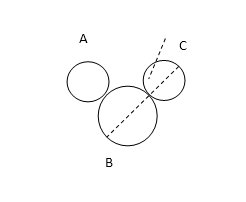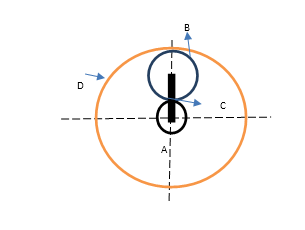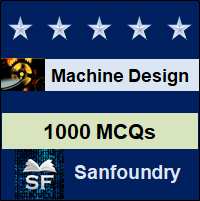This set of tough Machine Design Questions & Answers focuses on “Inerference, Undercutting & Backlash”.
1. Interference is caused by?
a) Overlapping of tooth profiles
b) Large size of dedendum
c) Meshing of involute and no-involute profiles
d) All of the mentioned
View Answer
Explanation: In some cases, portion of tooth below base circle is not involute due to large dedendum. This leads to overlapping of involute portion of teeth with the non-involute portion of the teeth.
2. Interference can be removed by under cutting.
a) True
b) False
View Answer
Explanation: Undercutting removes the interfering portion of the tooth.
3. Interference is maximum when the largest pinion is in mesh with the smallest gear.
a) True
b) False
View Answer
Explanation: It is maximum when smallest pinion is in mesh with the largest gear.
4. Undercutting is consider healthy for the tooth as it eliminates undercutting.
a) True
b) False
View Answer
Explanation: Although it eliminates undercutting but it also weakens the strength of the tooth and removes a small involute portion near to the base circle.
5. Backlash is defined as
a) Difference in the width of tooth space and engaging tooth thickness
b) Amount by which engaging tooth thickness exceeds the tooth space
c) Other name for interference
d) None of the listed
View Answer
Explanation: Backlash is the amount by which tooth space exceeds the engaging tooth thickness.
6. The amount of backlash depends on
a) Diameteral pitch
b) Module
c) Centre distance
d) All of the mentioned
View Answer
Explanation: Module and diameteral pitch are the same thing, and centre distance is also a factor while deciding the magnitude of the backlash.
7. The two teeth have thickness t₁ and t₂. If backlash of t₁ is greater than that of t₂, than
a) t₁ > t₂
b) t₁ < t₂
c) t₁ = t₂
d) None of the mentioned
View Answer
Explanation: Backlash=Tooth space-tooth thickness, greater the backlash lower is the tooth thickness.
8. A gear train consist of spur gear as shown. Gear A receives 4kW of power at 750rpm through its shaft and rotates in CW direction. Calculate the torque on the gear A.

a) 51N-m
b) 48N-m
c) 46N-m
d) 44N-m
View Answer
Explanation: M=60×10⁶x4/2πx750.
9. A gear train consist of spur gear as shown. Gear A receives 4kW of power at 750rpm through its shaft and rotates in CW direction. Calculate the torque on the gear B.

a) 47N-m
b) 51N-m
c) 0
d) Infinity
View Answer
Explanation: Gear B is an idler gear and thus transmits no torque.
10. A gear train consist of spur gear as shown. Gear A receives 4kW of power at 750rpm through its shaft and rotates in CW direction. A gear train consist of spur gear as shown. Gear A receives 4kW of power at 750rpm through its shaft and rotates in CW direction. Calculate the torque on the gear C if number of teeth on gear A, B and C are 40, 70 and 30.

a) 66N-m
b) 68N-m
c) 53N-m
d) 45N-m
View Answer
Explanation: M(a)xN(a)=M(c)xN(c) as the power transmitted is same.
11. A gear train consist of spur gear as shown. Gear A receives 4kW of power at 750rpm through its shaft and rotates in CW direction. Calculate the tangential gear tooth force. Module of the gear is 5mm.

a) 510N
b) 526N
c) 544N
d) None of the listed
View Answer
Explanation: P=2M/d or P=2×51/5×40.
12. A planetary gear train is shown in the figure. Number of teeth on the sun gear A, planet gear B and fixed ring gear D are given by 30, 70 and 140 respectively. Module is taken as 5mm. Calculate the length of the arm C.

a) Missing data
b) 250mm
c) 330mm
d) 240mm
View Answer
Explanation: L=[Da+Db]/2 where da=5×30 and Db=5×70.
13. A planetary gear train is shown in the figure. Number of teeth on the sun gear A, planet gear B and fixed ring gear D are given by 30, 70 and 140 respectively. Module is taken as 5mm. Calculate the tangential component of gear tooth force.

a) 220.6N
b) 303.2N
c) 454.7N
d) 633.2N
View Answer
Explanation: P=2M/5×30 where M=60×10⁶x(kW)/2πN.
14. A planetary gear train is shown in the figure. Number of teeth on the sun gear A, planet gear B and fixed ring gear D are given by 30, 70 and 140 respectively. Module is taken as 5mm. A pair of spur gears consist of 25 teeth pinion meshing with a 115 teeth gear. The module is 5mm. Calculate the gear ratio.

a) 5
b) 4.6
c) 5.2
d) 4
View Answer
Explanation: i=115/25.
15. A planetary gear train is shown in the figure. Number of teeth on the sun gear A, planet gear B and fixed ring gear D are given by 30, 70 and 140 respectively. Module is taken as 5mm. Calculate the shaft angle for opposite hand of helix if helix angle of two gears are 20⁰ and 17⁰.

a) 17⁰
b) 20⁰
c) 37⁰
d) 3⁰
View Answer
Explanation: For same hand of helix, shaft angle=difference of helix angles of two gears.
Sanfoundry Global Education & Learning Series – Machine Design.
To practice tough questions and answers on all areas of Machine Design, here is complete set of 1000+ Multiple Choice Questions and Answers.
If you find a mistake in question / option / answer, kindly take a screenshot and email to [email protected]
- Check Metallurgical Engineering Books
- Practice Mechanical Engineering MCQs
- Practice Metallurgical Engineering MCQs
- Apply for Metallurgical Engineering Internship
- Check Mechanical Engineering Books

